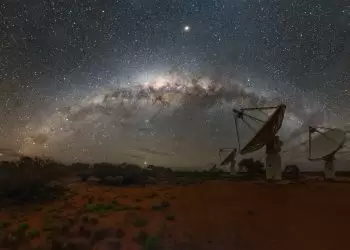At first, scientists thought the mysterious signals were just interference. But eventually it became clear something was out there.
The ‘something’ was a phenomenon called a ‘fast radio burst’. Short pulses of radio waves that are near impossible to detect — unless you have a very big telescope and someone who knows how to spot them.
That’s where the CSIRO’s Dr Keith Bannister comes in. As an engineer and astronomer, Bannister not only knows what’s out there but also how to build the machines that can help scientists study it.

This know-how helped him modify the CSIRO’s Australian Square Kilometre Array Pathfinder (ASKAP) radio telescope to detect fast radio bursts.
“After we adapted ASKAP to spot them, we doubled the number of bursts known at the time,” Bannister told create.
Bannister was recently awarded the Malcolm McIntosh Prize for Physical Scientist of the Year at the 2021 Prime Minister’s Prizes for Science.
From a galaxy far, far away
It’s impossible to predict when or where a fast radio burst will come from, so scientists need a telescope like ASKAP that can see vast amounts of the sky.
The issue is making sure the telescope knows what to look for.
“We had to update the ASKAP digital system so that it could process data in real time, which gives us a much better chance of spotting them,” Bannister said.

While the exact nature of fast radio bursts is still unknown, Bannister’s modifications helped the team identify where the bursts are coming from — literally a galaxy far, far away.
This information can be used to unravel some of the other mysteries of our universe, such as the density of our universe.
‘I kept thinking, what happens next?’
While becoming an astronomer wasn’t always on the cards, Bannister was set on becoming an engineer from an early age.
“I studied electrical engineering and ended up working for an aerospace company in the UK,” he said.
“We were sent on a course to do systems engineering and one of the exercises was designing a space telescope.
“At the end, the other engineers dusted their hands like, ‘that’s done’, and I kept thinking, ‘what happens next?’.”
“Looking back, I didn’t realise you could make a career out of this sort of thing,” Banister said. “But astronomy and engineering are actually a really nice match.”
In fact, Bannister thinks it helps being able to understand the instruments they use and how they can be used in the best way possible.
“Part of good astronomy is pushing things to the limit. So you’re creatively using a telescope in a way that it maybe wasn’t designed to be used,” he said.
On the shoulders of giants
While Bannister’s work is ground-breaking in its own right, he’s quick to acknowledge the engineers and scientists who paved the way.
One of the engineers that helped build ASKAP was John O’Sullivan, one of the co-inventors of fast WiFi. O’Sullivan had tried to look for fast radio bursts in the ‘70s, inspired by a theory from Stephen Hawking and astrophysicist Martin Rees.
“It’s a privilege to be part of it,” Bannister said.
“You have Einstein who’s talking about black holes, and then Stephen Hawking who says that they evaporate. And then Martin Rees says, ‘Well, they might have been radio pulses’.”
And then Dr Keith Bannister found out they really existed.
World-class engineering
Bannister’s work doesn’t end here. He’s currently working on speeding up the current system so ASKAP can spot fast radio bursts even quicker.
“We have to process about 30 trillion pixels a second, which is about the equivalent of a million people watching YouTube at once,” Bannister said.
“And we have to do it in a machine the size of a fridge. So that’s the challenge at the moment.”
Thankfully, Australia is one of the best countries in the world to do this kind of engineering. Bannister believes the nation is world leading when it comes to radio astronomy.
“I think that’s largely because the engineering we do is world class,” he said.
“In astronomy it’s usually the person with the biggest, best telescope that makes the most important discoveries, so you need the best engineers working on them.”
Bannister said he’s grateful for the opportunities he’s had and wants to encourage other engineers to pursue their interests.
“There’s more opportunities than you realise,” he said. “If you have the enthusiasm and drive, opportunities can open up in ways you might not have thought possible.”
